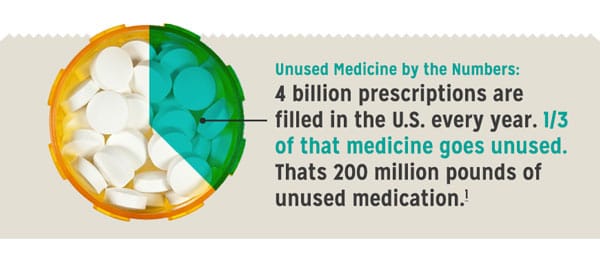The problem with household pharmaceutical waste

Information and graphic provided by the Tri-County Health Department
Unwanted or expired medications are often a common sight in the medicine cabinet. Storing unwanted medications – prescription or over the counter – in the household can pose the risk of accidental ingestion, especially for children and the elderly.
Traditionally, unused medications have been disposed of by flushing them down the toilet or pouring them down the sink. This method however, can lead to environmental pollution, because most wastewater treatment plants and septic systems are not designed to remove pharmaceuticals and their related compounds. Eventually, the pharmaceuticals make their way into rivers and groundwater. A national study by the U.S. Geological Survey in 2000 found the presence of a class of pollutants which includes pharmaceuticals in 80 percent of the streams they sampled.
Several new studies have also shown that this type of pollution can potentially impact aquatic wildlife. In one study, scientists in Colorado discovered a link between a type of pharmaceutical compound found in a local stream and changes in the reproductive characteristics of the fish there. The potential for human exposure also exists when the water is eventually reused.
Household pharmaceutical waste disposal methods for unused and unwanted pharmaceuticals are very limited. Disposal programs at the state and local levels are only in the beginning stages of development, as are pharmacy medication take-back programs. In the absence of those, the best method for disposing your medications is to throw them out in your regular household trash. Today’s landfills are constructed to meet strict environmental regulations that prevent the release of contaminants into the environment. See the following for step-by-step instructions to dispose of unwanted medication in the household trash.
Take the following steps before placing unused, unneeded, or expired medications in the trash:
1. Remove the pharmaceuticals from their original containers – Place them in non-descript containers such as a coffee can or margarine tub, to conceal the medication.
2. Alter the medication – Pills and capsules: pour enough water into the container to dissolve them. Liquid medications: mix in flour, table salt, charcoal, kitty litter or even non toxic pungent spices to deter anyone from consuming it.
3. Throw it out – Place the medication directly in the trash can as close to your garbage pickup time as possible.
4. Never flush medication down the toilet or pour them down the sink.
Additional Resources:
List of Medication Drop-off Locations in Colorado: www.colorado.gov/pacific/sites/default/files/PW_ISVP_Controlled-Substance-Permanent-Drop-Box-Locations.pdf.
U.S. Geological Survey (USGS) on pharmaceuticals in the environment: http://toxics.usgs.gov/regional/emc/.
U.S. Environmental Protection Agency (EPA) pharmaceuticals in the environment: www.epa.gov/endocrine-disruption.
Tri-County Health Department serving the residents of Adams, Arapahoe and Douglas Counties: www.tchd.org.